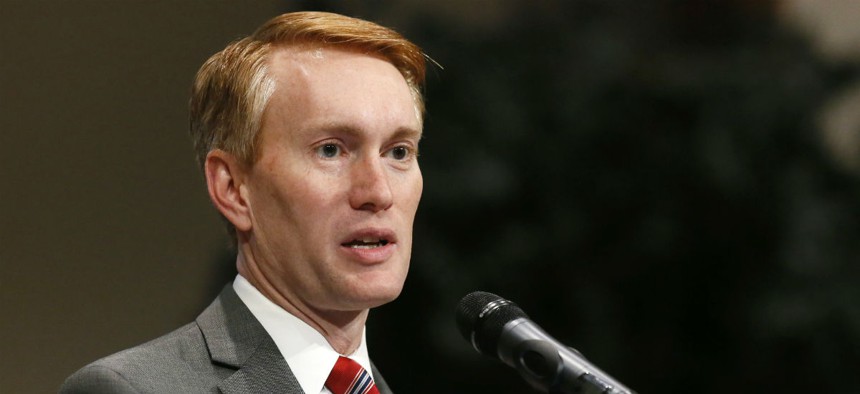Agencies Promise Efficiencies, but Not Workforce Cuts in Reorganization Plans
Leaders say they are gatherings thousands of reform proposals from the rank and file.
Federal agencies working to restructure themselves are focusing primarily on serving their customers better rather than ways to cut the workforce, leaders told a Senate panel Thursday, which promised thorough oversight of the Trump administration’s reorganization efforts.
Agency leaders said they were taking seriously suggestions from their rank-and-file employees on how to institute more efficiencies as part of their reform planning. The Senate Homeland Security and Governmental Affairs Committee’s panel with federal workforce oversight held the hearing to discuss with officials from various agencies their progress in implementing Trump’s executive order and the subsequent memorandum from the Office of Management and Budget, titled the Comprehensive Plan for Reforming the Federal Government and Reducing the Federal Civilian Workforce.
Preliminary, high-level plans to implement that guidance are due from every agency to OMB at the end of the month; all four agencies represented at the hearing said they would meet that deadline.
Sen. James Lankford, R-Okla., who chairs the Regulatory Affairs and Federal Management Subcommittee, said after the hearing he was not surprised agencies were not prioritizing workforce cuts. No agency representative laid out any plans to slash jobs.
“It looks big and bold” in the title, Lankford said of the workforce cutting provisions of OMB’s memo, “but if you look at the text, it’s not required.” Lankford added he would have no interest in instituting such a requirement.
Don Bice, the Agriculture Department’s associate director of the Budget and Program Analysis Office, said USDA’s review would not pay particular attention to personnel cuts, despite OMB asking for an update by the June 30 deadline on near-term efforts to slash workforce rolls.
“We’re focusing on how do we serve the customer better,” Bice said, “not necessarily how we reduce the workforce.”
Trump’s budget called for a 21 percent cut to Agriculture’s budget. Sen. Heidi Heitkamp, D-N.D., said it was unrealistic to expect the department to reach such drastic spending reductions through efficiency measures. While the full force of Trump’s proposed cuts is unlikely to be approved by Congress, all agencies are currently planning for that contingency. A preliminary reorganization effort already under way at USDA will not require any workforce cuts, the department has said.
Rather than discussing efforts to eliminate employees, agency leaders emphasized their attempts to engage their workers for feedback on ways to improve their operations. The Homeland Security Department, for example, has launched a questionnaire on its intranet soliciting feedback from its staff. Michael Stough, DHS’ director of Program Analysis and Evaluation, said this “bottom-up approach” has led to 2,300 suggestions from employees that a DHS team is combing through on a daily basis. He added the department has received 50,000 additional suggestions through OMB’s solicitation for public comment on reorganizing government; OMB has distributed a total of 110,000 public comments to agencies
“The department recognizes that there is no one more interested in achieving the goals and objectives of DHS than the individual employee,” Stough said, noting the deputy secretary has gone on a listening tour to gather “ideas for improving effectiveness.”
“Sometimes,” he added, “the most innovative ideas come from our employees.”
Ellen Herbst, the Commerce Department’s chief financial officer, said leadership is engaging employees at individual bureaus and offices. It is also soliciting feedback from unions though its labor management forum.
Lee Lofthus, the Justice Department’s assistant attorney general for administration, said he is gathering input from every level of every component.
“We are taking ideas from anywhere we can get it and I think that’s the way to do it,” Lofthus said.
Lawmakers encouraged the agencies to make their workforces a part of the process, or risk alienating them.
“If you devalue your workforce, they’ll vote with their feet,” Heitkamp said, explaining they would seek other employment or retire. She added: “This exercise has to be done not solely as an exercise of efficiency, but it has to be done as a reaffirmation of the mission and the goals.”
While agencies boasted of their inclusive efforts, not everyone has felt their voices embraced. National Treasury Employees Union President Tony Reardon submitted testimony to the subcommittee that Agriculture, DHS and others have ignored submissions from frontline employees. Suggestions have included bringing more employees into supervisors’ area of responsibility, increasing opportunities for telework and improving work processes.
“There are certainly areas where efficiencies can be found,” Reardon said before the hearing. “There are ways frontline employees can help identify those and actually help strategize and create work processes that create some of those efficiencies.”
Agencies are in the process of examining the feedback they have received from an array of sources in preparation for the looming deadline. Lofthus said, for example, his team will bring ideas before the associate and deputy attorneys general, as well as Attorney General Jeff Sessions, next week before issuing their final draft to OMB.
Heitkamp promised the subcommittee would continue to oversee implementation of the memo in the months to come.
“This is just introductory,” Heitkamp said. “You will see us over and over and over again.”




